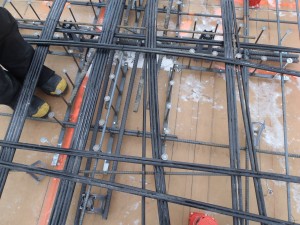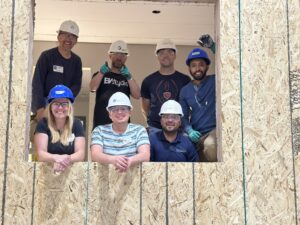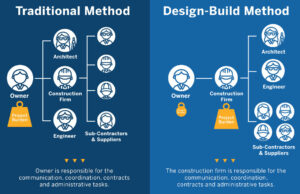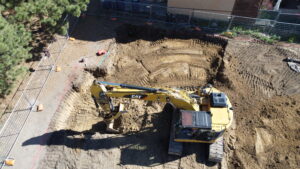A couple of weeks ago, I visited a site where they were laying out their first post-tension elevated deck pour. While I was there, I realized that there’s a bit of post-tension wisdom that doesn’t get propagated as far as it should: how to sweep a post-tension tendon bundle correctly.

One of the great advantages of post-tension is that it’s flexible, both metaphorically and physically. There are lots of applications for post-tensioning — foundations and elevated slabs being the most common — but the cables themselves can bend to deviate around penetrations in the slab, and sweep to follow load paths that aren’t perfectly rectilinear. However, there are issues that can arise when this is done, and precautions that need to be taken to mitigate them.
Anyone who has visited a post-tension deck shortly before the pour has seen “hairpins”. These are pieces of rebar bent into a “U” shape (or a “bobby-pin” shape), and used like bobby pins, to hold tendons in place during stressing operations. Every issue that comes into play with swept tendons can be partially mitigated by using hairpins, but it’s important to understand why they’re used — I’ve seen applications where hairpins were applied incorrectly that greatly reduced their effectiveness.
The primary issue is that the tendons exert a lateral force inside the slab. As the tendons are stressed, they try to straighten out — in every direction. In general, this lateral force doesn’t cause movement (it’s acting on a “beam” that’s several feet deep), but when there aren’t several feet of concrete (say, because there’s a 4″ plumbing sleeve that the tendons were swept around), the tendons aren’t adequately restrained, and they can move. For this reason, engineers and post-tension material suppliers generally don’t allow sweeps within 24″ of internal corners or large block-outs, and strongly suggest that penetrations within the swept area be sleeved with schedule 40 steel pipe. Hairpins are also helpful in this situation because the “legs” engage the concrete that is outside the sweep — the portion of the “beam” that is in compression — and hold the tendon back.
The second issue — which prompted this article — stems from the fact that the post-tension tendons are round. When the bundle is swept, all of the tendons try to straighten out, and when the strands are bundled together, there’s no concrete between them to hold them in place. In that circumstance, the outer tendons push on the middle tendons, and the middle tendons are squeezed between them and the inner tendons. Frequently, this causes the middle tendon to “pop” up or down . . . putting a section of the concrete in tension, and sometimes blowing a patch (or “scab”) off the slab. “Blowing” is the correct word — there’s a lot of energy in post-tension tendons, and the scab may separate with enough to send it flying dozens of feet. Hairpins are used to prevent this as well, but they do nothing if they’re looped around tendon bundles. Hairpins must be inserted between individual tendons in order to prevent rolling . . . because that ensures that the tendons aren’t in contact, and thus can’t roll over each other.
Post-tensioning is a powerful tool for any structural designer, but a solid design is only half the battle. A team with the experience to recognize field issues is critical as well. EVstudio has a long track record of successful post-tension projects — we’re happy to add yours to our résumé.










